Table of Contents
This report is one of a series published by the Federal Bureau of Mines to describe methods and costs of mining uranium on the Colorado Plateau. The Navajo Uranium Division of Kerr-McGee Oil Industries, Inc., mines uranium from several deposits of carnotite-type ores, which lie buried in the Lukachukai Mountains on the Navajo Indian Reservation, Apache County, Ariz. The country is rugged and isolated. Constructing and maintaining roads has been a continuous task.
The ore bodies occur within the Salt Wash member of the Jurassic Morrison formation and are similar to other such deposits on the plateau. The current mining activity in the Lukachukai Mountains is a result of uranium-ore discoveries in 1949, although the Navajos undoubtedly knew of the outcrops of yellow uranium minerals long before that time. The ruggedness of the country and the heavy soil cover over much of the surface hampered prospecting, but probably the main reason the ore was not found sooner is that no one took the trouble to look for it in the Lukachukai Mountains.
Except for supervisory and service personnel, Kerr-McGee employs Navajos in its mines, and including its small contract-sharing operations, has 65 to 70 Indians on its payroll- An interesting feature of the Lukachukai mines is the wheelbarrow haulage used in the stopes. Surprisingly, the tons of ore produced per man-shift is higher than the average at other Salt Wash mines on the plateau.
The largest mine in the Lukachukai Mountains is the Mesa No. 2 mine. This 5,000-ton-a-month operation is developed through two low-level haulage adits and employs a room-and pillar system of stoping. The Atomic Energy Commission (AEC) classifies the ore as carnotite-tyuyamunite having a high-vanadium and low-to-medium lime content.
Kerr-McGee’s Navajo uranium mines are in the Lukachukai Mountains on the Navajo Indian Reservation, Apache County, Ariz., about 10 miles west of the Arizona-New Mexico border and about 32 miles south of the Arizona-Utah border (figs. 1 and 2). The Lukachukai Mountains are the northwestern spur of the Chuska Range, and Lukachukai Pass lies between them and the main mountain mass. The relatively flat-topped Chuska Mountains are about 60 miles long and trend northwesterly across the Arizona-New Mexico border. The highest part of the Chuska Range is the 9,808-foot-high Roof Butte immediately south of Lukachukai Pass. The altitude at the Mesa No. 2 mine is about 7,500 feet.
Kerr-McGee’s field camp at Cove, Ariz., is reached by traveling approximately 33 miles westerly across barren, arid country over a graveled road from its junction with U.S. Highway 666, 6-½ miles south of Shiprock, N. Mex. The Red Rock School and trading-post road junction, 12 miles from the mine camp, is passed enroute. Near the camp, Indian hogans are scattered among the pinon pine and juniper.
The Lukachukai Mountains terminate on the east and west sides as precipitous cliffs. On the west side, the mountains drop off to 5,600 feet at the start of a desert like expanse. Near Cove the mountains end in a series of cliff Timmed finger like ridges separated by twisting box canyons (fig. 3). The ridges pointing north and east, are not true mesas, but were named and numbered as such by the AEC when it began its drilling program late in 1950. The Mesa No. 2 mine is approximately 1,020 feet higher than Cove; it is reached by a dirt road that twists 4-½ miles southward up a canyon on the east side of Mesa No. 2. A southwest fork of the road is followed to the mine through a short side canyon between Mesa Nos. 2 and 1-¾. Other roads branch out and zigzag across the ridges. Building and maintaining access haulage roads has been a problem in this rugged country.
Ponderosa pine and quaking aspen grow in the higher country; and sage, pinon, and juniper cover the lower parts of the ridges.
Carnotite was discovered about 1918 in the Carrizo Mountains, a few miles north of the Lukachukai Mountains. Many claims were located within the next few years, although little mining was done until 1942, when the wartime need for vanadium increased.
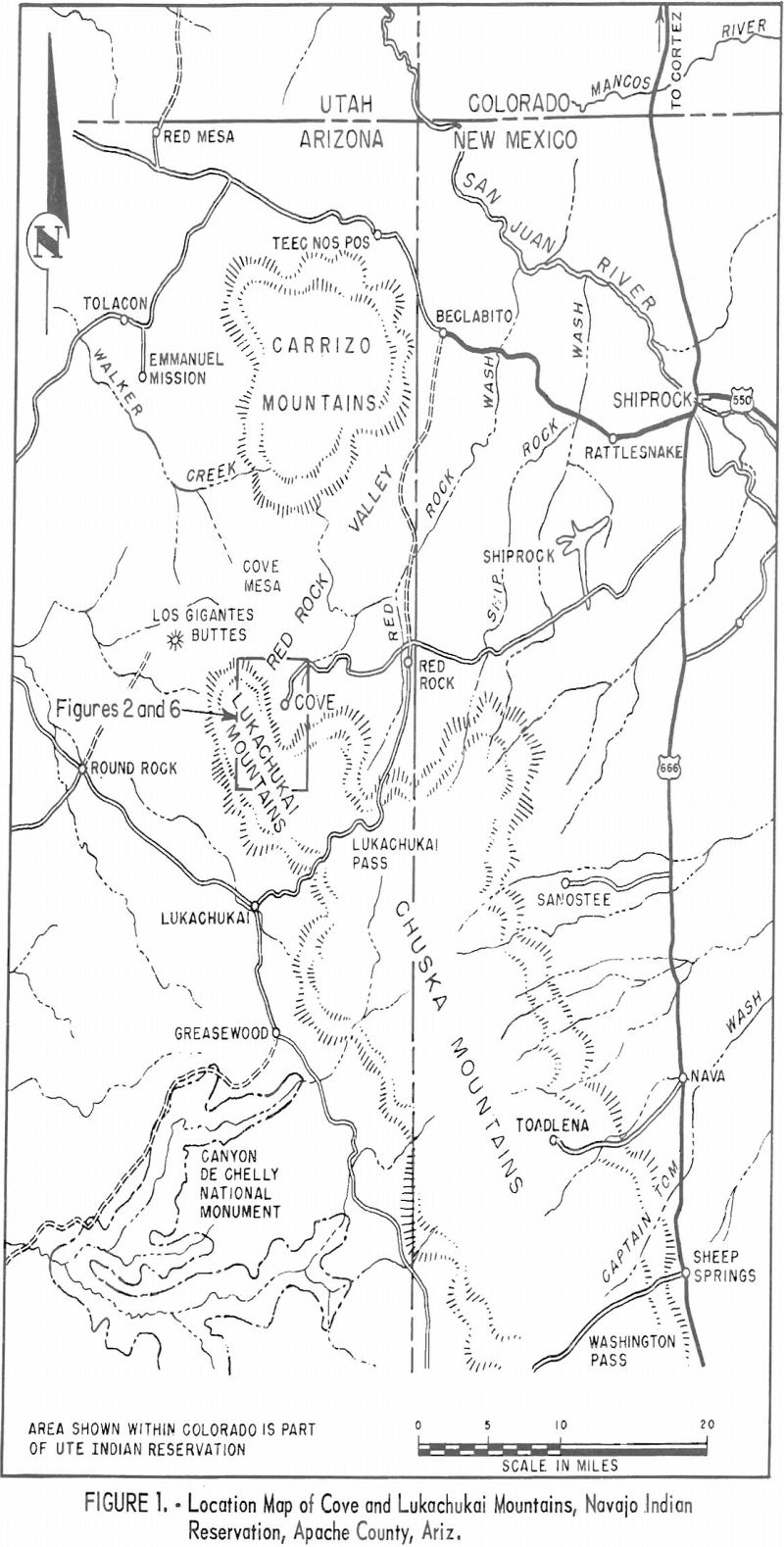
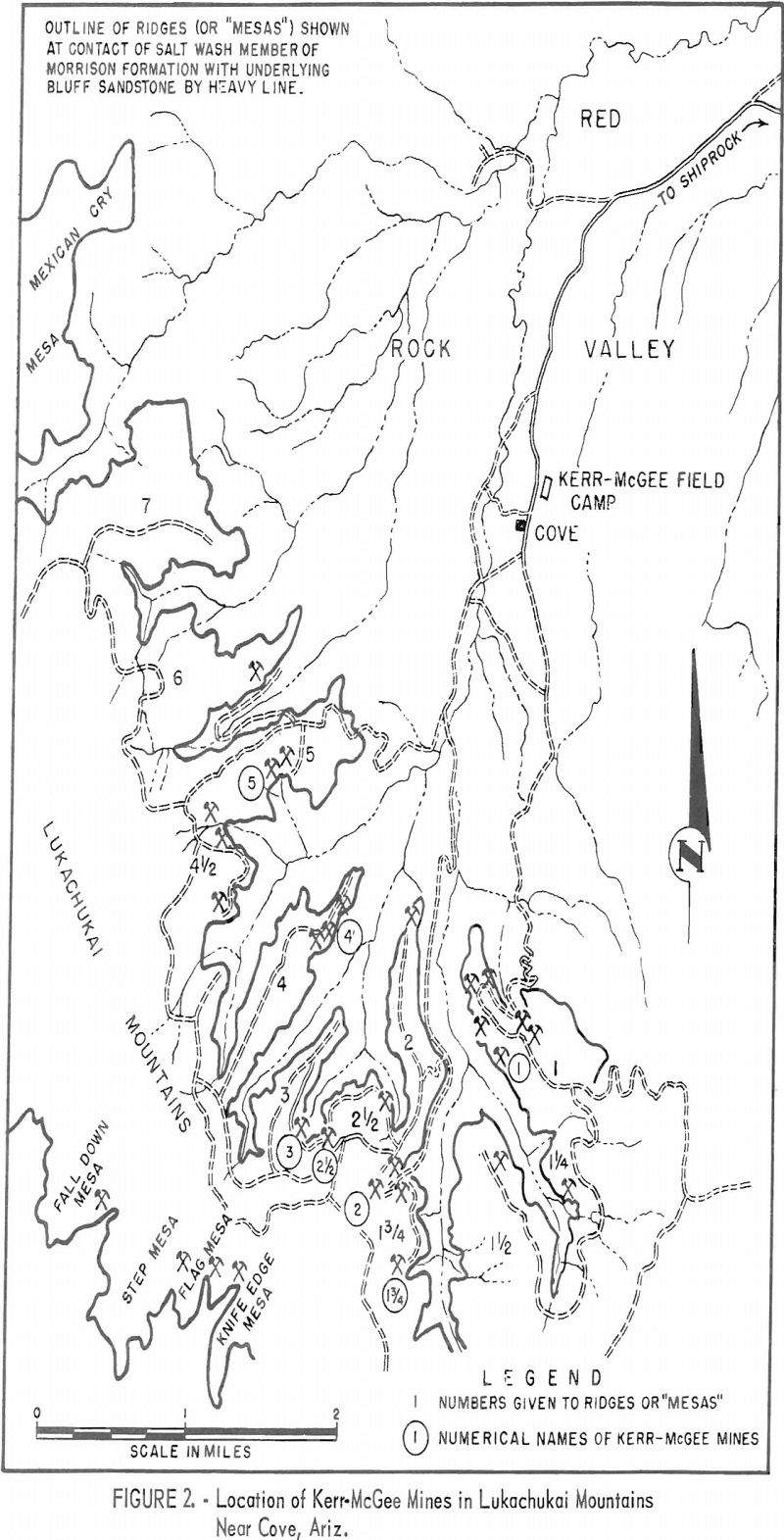
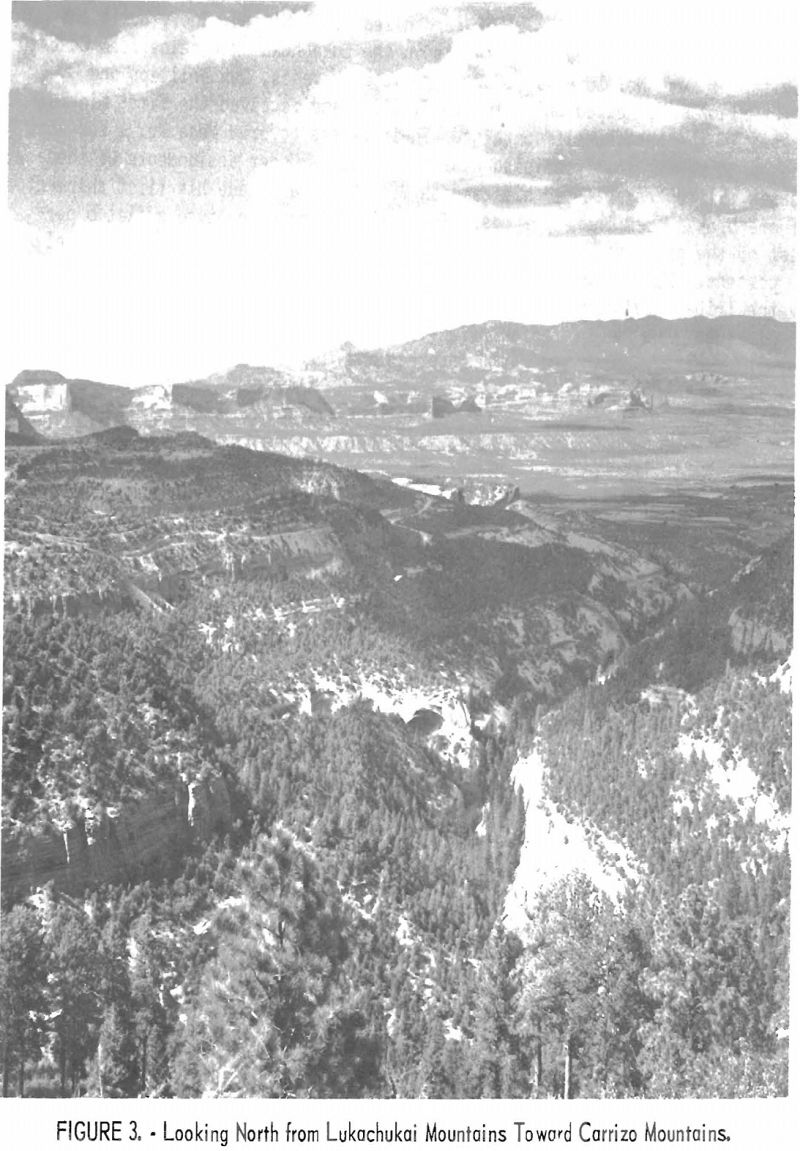
The first uranium-ore discovery in the Lukachukai Mountains was reported to have been made in 1949 by Dan Hays, of Monticello, Utah. Hays immediately had F. A. Sitton, of Dove Creek Colo, look at the discovery negotiate with the Navajo Tribal Council at Window Rock, Ariz., and later arrange with the Bureau of Indian Affairs Washington, D. C., for a mining lease. The search for uranium continued, mostly in the vicinity of Mesa No 1. One source reported that a Navajo named Willie Cisco discovered uranium in the Lukachukai Mountains in 1950.
Sitton, who on April 3, 1950, organized F. A. Sitton, Inc., built the first access road to uranium deposits in the Lukachukai Mountains from Cove to the top of Mesa No. 1 in May 1950. Two local Navajos, Dan Phillips and Koley Black, who helped build the road, filed and received the first mineral leases in the Lukachukai Mountains. Their leases covered Mesa No 1 and what looked to be the most promising nearby outcrops. Under assignments of these leases, Sitton established his camp on Mesa No. 1 and made his first shipment of ore broken from the exposures. The assignors have received a flat 5 percent of the gross value of the ore produced, and the Navajo Tribe has received 10 percent. Mining permits and leases issued later under regulations resolved by the Tribal Advisory Committee in September 1951 and approved by the Commissioner, Bureau of Indian Affairs, in November 1951 have a sliding-scale royalty. Sitton purchased Hay’s interest and then sold out to Dulaney Mining Co. late in 1950.
Climax Uranium Co., a subsidiary of American Metals Climax, Inc., began prospecting m the Lukachukai Mountains about the same time. In September 1950 the AEC built its field camp at Cove, and during the winter of 1950-51 completed its first exploratory drilling program on Mesa Nos, 1, 2, 3, and 4. Soon afterwards Climax Uranium Co. built a road to the top of Mesa No. 5 and then across to Mesa No. 4-½. The road from U S. Highway 666 to Cove was a dirt trail; and early in 1952, when the potential of the area was beginning to be recognized, the AEC began building the present haulage road.
During the summer of 1951 Dulaney Mining Co. employed Raymond Starr., a gold miner from Mancos, Colo., to sample and map all outcrops of ore found along the Salt Wash rims extending between Mesa Nos. 1 and 5. Kerr-McGee Oil Industries, Inc., became interested in the area partly because of Starr’s map, and in May 1952 acquired the property and formed its Navajo Uranium Division. From May 1952 until June 1954; while its mill was under construction at Shiprock, Kerr-McGee’s temporary offices were in Cortez, Colo. The mill went onstream November 1, 1954, The first company field camp was the Sitton camp on Mesa No. 1, but in October 1954 the camp was moved to Cove., a more central position among the mines.
Early mining at the Mesa No. 1 mine (fig. 4) was somewhat discouraging, for the ore was spotty and much underground exploration work was necessary. Only limited, widely spaced drilling had been completed, and it was thought that the irregularity of the ore did not justify an expensive core-drilling program. Rotary and deep percussion drilling had not yet come into wide use on the plateau. The haulage level# started in the ore zone, was awkward. A large ore body was discovered in 1953 on Mesa No. 3, and the company then had a chance to lay out a haulage level that permitted stoping most of the ore above track (fig. 5). Larger ore bodies were discovered on Mesa No, 2 by company drilling in 1955; development work was begun in February 1956; and stoping the following December.
Most of the mining permits in the Lukachukai Mountains issued before 1954 were issued to relatives of Dan Phillips, a Navajo, who lived in the vicinity of Cove. Under tribal law, a permit can be issued only to a Navajo. The maximum ground that any individual can hold either under a permit or lease, or
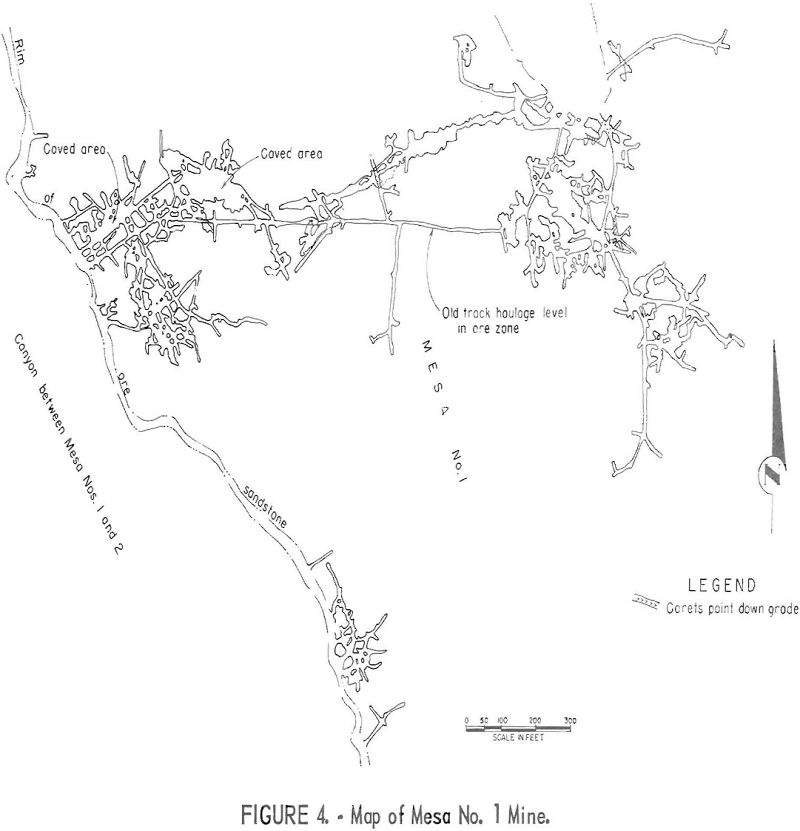
both is 960 acres. although the Advisory Committee of the Tribal Council can grant additional acreage to ore processors. The lease or permit holder can assign his mining rights under Tribal mining regulations.
The scale of royalties paid the Navajo Tribe under regulations approved by the Tribal Advisory Committee in September 1951 is as follows:
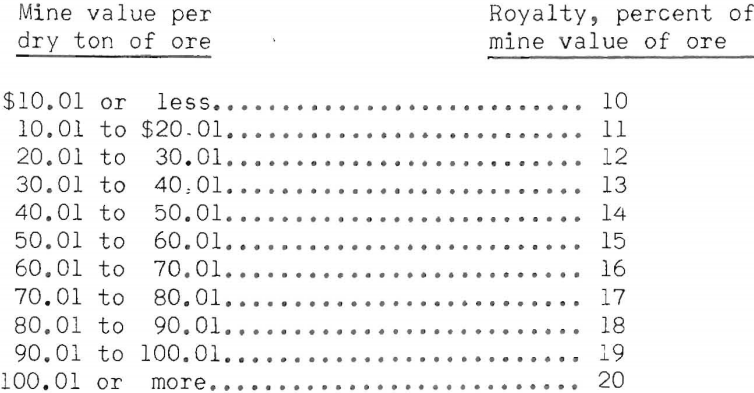
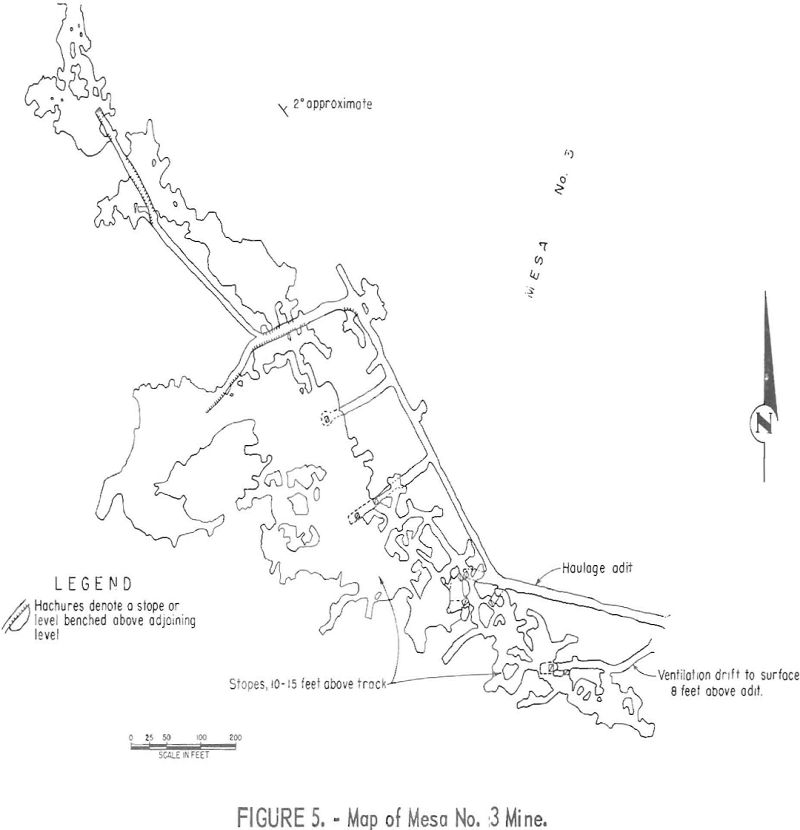
The scale of royalties paid the Navajo assignor is as follows:

The mine value of the ore is the dollar value per dry ton of crude ore as paid by a Government agency or other buyer, less any allowances for transportation or development, and less any treatment cost. When minerals or other products are recovered that are not included in determining mine value per dry ton, the Tribe receives an additional royalty of 10 percent of the gross value of such products.
The Tribe also receives 10 percent of any bonus paid by the AEC for the production of ore.
Labor and Living Conditions
The assignments of Navajo tribal mining permits specify that Navajo Indians be employed in mines on the reservation in all positions for which they are qualified. Kerr-McGee employs 65 to 70 Navajos. Its supervisory and service personnel, ranging from the mine superintendent to the camp cook, total 13.
The company’s camp at Cove consists of a number of small prefabricated buildings. The supervisory and service personnel live at the camp and commute on weekends to their homes in Shiprock or Cortez. The company charges each person $2.00 rental a month for a cabin and $0.50 each for family-style meals eaten at the cookhouse. During the first 2-½ years, while the company ran its mining operations from its camp atop Mesa No. 1, excellent shortwave radio communication was established between the camp and the offices in Cortez and Shiprock. When the camp was moved to the foot of the mountains at Cove, communication by radio was poor, and a telephone connection was made to the Bureau of Indian Affairs telephone line. Power for the small camp is furnished by either of two 10-kw. propane-powered electric plants.
When Kerr-McGee first began mining on the reservation, the turnover of Navajo labor was very high, mainly because many of the men did not easily accept routine. Normal to their way of life, the Indians worked only long enough to satisfy their immediate needs. Attendance improved steadily, and by mid-1958 Kerr-McGee had a good core of reliable men averaging 3 years of service with the company. Labor turnover still was approximately 20 percent every 6 months. Absenteeism without prior notification was at one time of major concern, but this also lessened. Although the Navajos are conscientious and hard-working miners, it is only within the last few years that they have appreciated the need for reporting daily to the job. Vacations have become important; the company has one vacation plan for all employees-1 day of vacation for each month worked in the preceding year up to a maximum of 11 days. The realization that some miners get paid for 11 days of idleness has had a decided effect on the attitude and reliability of many others. Employees at any Kerr-McGee mine can participate in company-employee plans such as hospital and medical insurance, life insurance; retirement, and a thrift program.
Except for a very few who had worked in the lead-zinc mines at Rico, Colo, the Navajos employed at the No. 2 mine had no prior underground experience. The supervisors stated that the older men show little interest in learning to operate equipment and usually prefer to remain as muckers. The younger men, however, take a keen interest in learning, and after some experience acquire good mechanical ability. Moreover the younger men are more responsive to direction.
The company has conducted regular biweekly first aid and safety meetings. At these meetings safety at home and on the highway is also stressed. One of the principal aims of these meetings is to acquaint the Navajo with the need and obligation to give first-aid treatment to a person who is injured or ill until professional aid is obtained. An ancient superstitious fear of the dead and the dying is fading but is still strong enough to stop some of them from giving aid to an injured or unconscious person.
To transport equipment and personnel to and about the operations, the company maintains nine vehicles, ranging from a 6 by 6 Army-surplus logging truck to a probe-rigged jeep. All except one have all-wheel drives, a feature of much importance in the Navajo country. The company keeps mudgrip tires mounted on its vehicles year-round. For roadbuilding Kerr-McGee uses a Caterpillar D-8 tractor; an International TD-9 tractor loader is used for various jobs.
Mine-road maintenance is almost a continuous task. During the spring runoff, the roads become quagmires. During the summer, truck traffic pounds the surface of the main routes into a heavy mantle of dust, and occasional heavy downpours disrupt traffic by cutting out sections of road. The bulldozer operator has virtually a year-round road job. From December to May he maintains the main haulage roads, keeping the snow off, ditches open, side sloughs cleaned, and the muddy stretches passable. In the spring he spends much of his time freeing the trucks from mud in which they occasionally become stuck even on downhill trips. During the rest of the year he makes major road repairs, such as replacing culverts, and spends much time building access roads for the drill crew. When a flash flood has cut out a section of the road between the camp and Shiprock, the company often has found it expedient to make the necessary repairs to keep its ore shipments moving.
Most equipment repairs can be made at the field shop. Additional shop facilities and repairmen are available at the mill shops in Shiprock.
Description of Deposits
Most of the mesas are capped with Jurassic Morrison sediments (fig. 6). The basal Salt Wash member of the Morrison formation ranges from 100 to 125 feet thick and consists of lenticular beds of fine-grained sandstone interlensed with thin beds of mudstone. The Salt Wash weathers to form wide benches and low cliffs. In the vicinity of ore deposits the sandstone is usually light brown to gray, and the mudstone is greenish or bluish gray, a promising guide when exploring for new ore bodies. Sandstone composes 60 to 70 percent of the Salt Wash near most of the major ore bodies. At the top, the Salt Wash tongues with and grades into the Recapture member, which is about 400 feet thick in the Lukachukai Mountains. Like the Salt Wash, it consists of lenticular cross stratified sandstone interlensed with mudstone but is darker, less resistant, and contains coarser grained sandstone. The Westwater Canyon member tops the Morrison formation in the Lukachukai Mountains, and like the Salt Wash and
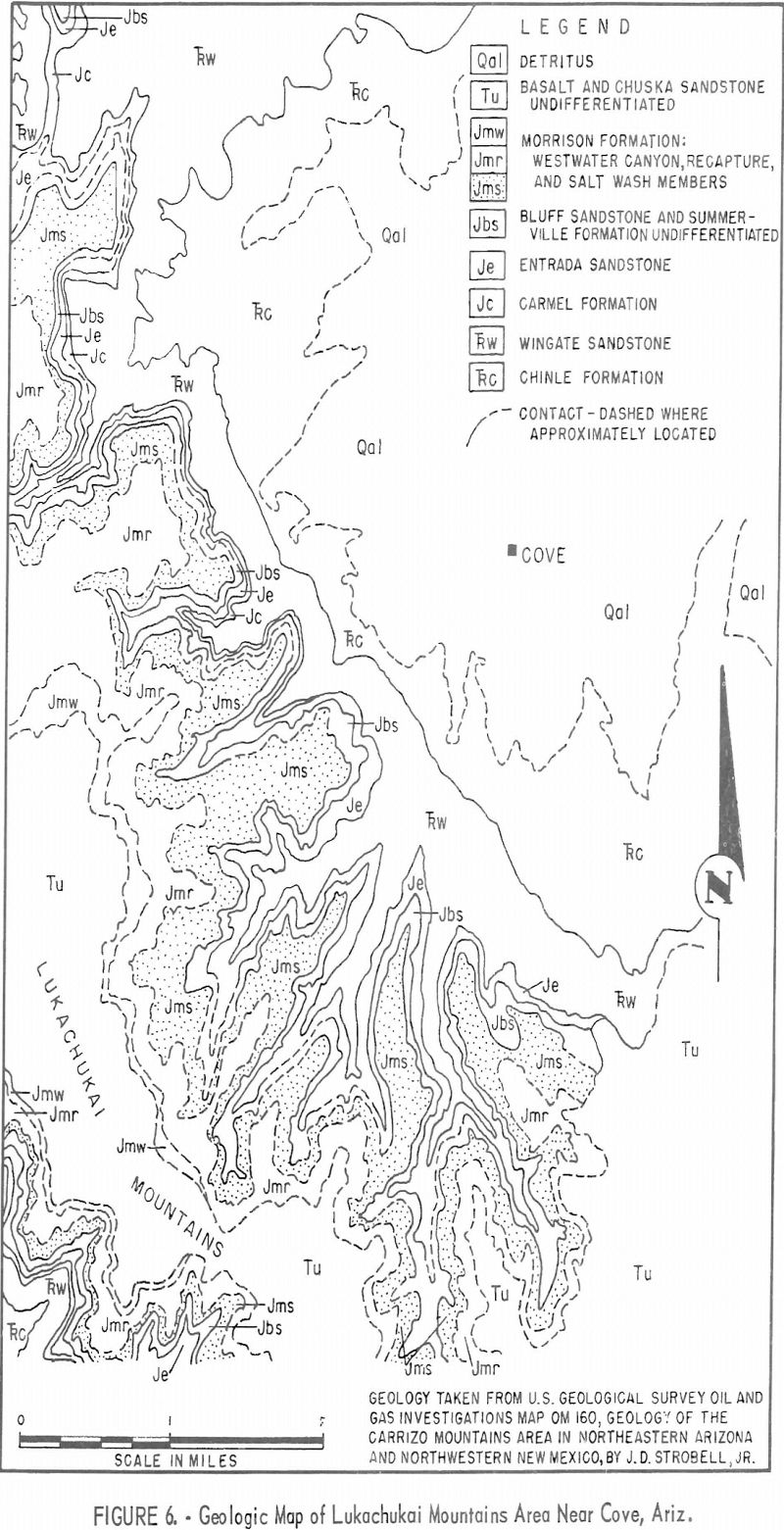
Recapture, is composed of sandstone and mudstone with sandstone predominating. Like the Salt Wash, it is lighter in color than the Recapture. Beneath the Salt Wash lies the orange-tan Jurassic Bluff sandstone, which forms a prominent rim.
The Salt Wash ore bodies at the Mesa No. 2 mine lie 40 to 60 feet above the Bluff contact in beds that strike N. 30°-45° W. and dip 1°-2° NE. The ore bodies occur as lenticular masses of various sizes and shapes within paleo-stream channels. Much of the ore and most of the high-grade ore is near the flanks of these channels, but occasionally lenses of ore abut an island of waste lying within the channel. The sandstone outside the channel is usually red and siltier. In the vicinity of the ore bodies on or near Mesa Nos. 2 and 3, the sandstone lenses containing the ore range from 20 to 30 feet thick, and often a blue mudstone is found beneath the ore and sometimes above it. Twenty feet of ore, the thickest stoped by Kerr-McGee, was found above the No. 2 north haulage adit. Usually the thicker ore, found in thicker sandstone is lower in grade than is the thinner ore, which is usually found in thinner sandstone near the flanks of the channel.
An interesting feature is the two distinctly overlapping and entirely separate ore layers mined through the south adit at the Mesa No. 2 mine. Many Salt Wash ore bodies are split, change elevation abruptly., or occur as shingled layers; however, few have exhibited such a strong degree of singularity. The two ore bodies lie in separate sandstone lenses separated by 5 to 10 feet of blue mudstone. The ore layers themselves are an average of 30 feet apart, vertically Kerr-McGee points out that the two ore bodies lie within separate channels, which cross at the No. 2 mine. Southwest of the No. 2 mine, the upper channel apparently curves northeasterly, crosses the No. 2 workings, and then arcs easterly toward the deposit mined on Mesa No. 1-¾ about 800 feet east. Northwest of the No. 2 mine, the lower channel apparently trends south-easterly from the No. 3 mine to the No. 2-½ mine, and then extends to the No. 2 mine. The ore mined from the small mine northeast of the No 2 mine was in the lower sandstone.
The ore minerals are carnotite, tyuyamunite, and some vanadium minerals. The average vanadium-uranium ratio of Kerr-McGee Lukachukai production has been 4:1. The ore as mined averages 8 percent moisture.
Bill Stevens, chief mining engineer-geologist, stated that other than the common lithologic guides to ore, the most favorable guide yet determined from drilling is a rapid change in elevation of an ore sandstone-mudstone contact. This usually accompanies a change in the thickness of the ore bearing sandstone but does not necessarily indicate proximity to the flank of a channel.
Exploration
Surface exploratory drilling is an integral phase of the Kerr-McGee Navajo operation. To find new ore deposits and to delineate those already discovered, Kerr-McGee drilled an average of more than 58,800 feet of rotary holes every summer for the last 6 years, beginning in 1953. Good drilling weather lasts about 6 months each year. Average drilling depths have progressively increased from 117 feet in 1953 to 294 feet in 1957 but decreased to 274 feet in 1958.
Kerr-McGee was one of the first companies to use rotary drills for uranium exploration on the plateau, bringing in truck mounted rigs used for seismic oil-exploration work in May 1953. In the summer of 1956 drilling was contracted to Walter Duncan Mining Co., of Durango, Colo. The single rotary rig used by the contractor is a Mayhew 1000 mounted on an International flatbed truck (fig. 7). The holes are drilled dry if possible, and compressed air is

furnished by a 570-c.f.m. single-phase, air-cooled. Gardner-Denver compressor mounted on the truckbed. Normal operating air pressure ranges from 20 to 32 p.s.i. Drill rod is 2-3/8 inches in size.
By contract, the driller is required to bore at least a 4-½-inch hole, most holes have been drilled 4-¾ inches. The drill operator uses the faster drilling finger or drag bit where possible but changes to a tricone bit to cut the harder sandstone. Most of the ground drills easily, and the contractor often has drilled more than 700 feet of hole in an 8-hour shift with the single rig. In 1958 the driller averaged 504 feet per working day, which included time spent in moving to new drill sites, 9-½ days lost in making major equipment repairs, and delays due to bed weather. The fastest rate of penetration was about 7 feet a minute through lenses of poorly consolidated sandstone. The holes are usually bottomed in a red mudstone, which lies beneath the ore sandstone. Usually the sides of a hole will slough slightly when the tool string is withdrawn. Therefore, the hole is bottomed a few feet below the potential sandstone to provide a spill pocket to collect the sloughed material. The radiometric probe then can reach and test the critical zone. It is left to the driller to decide the additional depth to drill, and he bases his decision on the condition of the ground penetrated and the depth to the ore.
Immediately after the driller moves off a hole, the company men arrive with a hole probe mounted in a station wagon. If the probe operator attempts to log a hole within 24 hours after it is bottomed and finds it caved, the driller is obliged to clean out the hole at no cost to the company. If logging is attempted 24 hours or more after bottoming, and the hole has caved, the driller receives one-half the original rates to clean out the obstruction. Drill cuttings are seldom caught, except for an occasional check of probing results or when first drilling in a new area. The company constructs roads and drill sites for the contractor.
The contracted rotary-drilling rates in 1958 were as follows:

An additional charge of $0.08 a foot is paid if water or wet shales are encountered and water instead of air has to be used as a coolant and chip-removing agent. Standby time is paid at the rate of $10 an hour, limited to 10 hours in a day. The contractor is paid $15 an hour for time spent enlarging an exploratory drill hole to an 8-inch-diameter ventilation hole. Usually the cost of enlarging averages under $1.00 per foot, but it has reached $1.33 per foot. If coring is desired the rate is $15 an hour. In 1957 Kerr-McGee’s cost to drill 192 holes, which averaged 294.1 feet deep, was $0.96 a foot; this included contract drilling, engineering and geologic work, probing, transportation, and incidentals.
Mesa No. 2 Mine
The company-operated Mesa No. 2 mine has been a large producer of uranium ore by Salt Wash standards. Its production has exceeded that of any other in the area of the Lukachukai Mountains. By December 1958, 84,660 tons of uranium ore had been produced from this 5,000-ton-a-month operation. The size and continuity of the Mesa No. 2 ore bodies have permitted the operator to lay out a low-level haulage system and employ a room-and-pillar method of extraction. The ore at the No. 2 mine has averaged 8 to 9 feet thick.
The mine is entered through two diverging haulage adits driven westerly from the head of a small canyon between Mesa No. 2 and the smaller Mesa No. 1-¾ to the south (fig. 8). Their portals are 80 feet apart horizontally, and the adits are serviced from the same mine yard. Ore brought out through both adits is dumped into the same storage bins. Guided by the results of exploratory drilling- the company drove the adits to roughly bisect the major ore bodies (fig. 9). The older 870-foot-long southernmost adit was begun in February 1956 and driven through red mudstone from 25 to 35 feet beneath the lower ore layer and about 60 feet beneath the upper ore layer. The adit first heads southwesterly, then turns almost due west. Exploratory drilling has found that ore extensions lie further south and southeast of the old stopes. These extensions will be developed through headings turned from this adit. A major crosscut will be driven to develop a large ore body lying midway between the No. 2 mine and the No. 1-¾ mine, 1,600 feet southeast.
The north haulage adit is being advanced to develop other ore bodies discovered downdip to the north and northeast. To keep about 30 feet beneath this downdip ore; its portal was cut about 10 feet lower than the south portal. It splits about 720 feet from the portal; its northeasterly or right fork was driven to develop ore lying in the direction of the dip, and the left fork was driven northwesterly to develop ore in the direction of the strike. On a plus-1-percent grade, the right or dip heading will intersect the northeasterly dipping ore zone approximately 900 feet from the fork, or about where the heading will connect with the workings of the small nonoperating mine about 1,200 feet northeast of the No. 2 mine portals. The left or strike heading will intersect the haulage level of the operating Mesa No. 2-½ mine about 1,000 feet northwest of the fork. The connection should aid greatly in ventilating the two mines. As of August 1958 4,000 feet of low-level haulageway had been driven at the No. 2 mine. It is estimated that approximately 4,500 feet of low-level haulage drift is yet to be driven.
Spaced 100 to 200 feet apart along the haulageways are short right-angled turnouts, from which one- and two-compartment raises link the lower levels with the stopes above. By staggering the raises 200 feet or less apart, the haul in the stopes seldom exceeds 100 feet which the operator considers to be the economic limit for wheelbarrow transportation. The raises have often been spaced according to contours along the bottom of the ore, so that the grades within the ore zones favor the loads if possible. The first raises from the older, south adit were driven alternately with one and two compartments; later, all raises were made two-compartment for better ventilation. The one-compartment raises are simply 6- by 6-foot raw-ore passes. The two-compartment raises are partitioned with stulls and laggingmaking the ore chutes about 5 by 5 feet.
For most of their lengths, the 7- by 7-foot haulageways penetrate red mudstone, which underlies the ore sandstone. The mudstone air slakes and sloughs easily, falling from the back and sides until a natural arch is formed. Even though a good arch is formed, the back often will continue to slough unless it is stopped by a sandstone parting or held by timber. Sloughing of the sides often will continue as long as it does at the back. To control
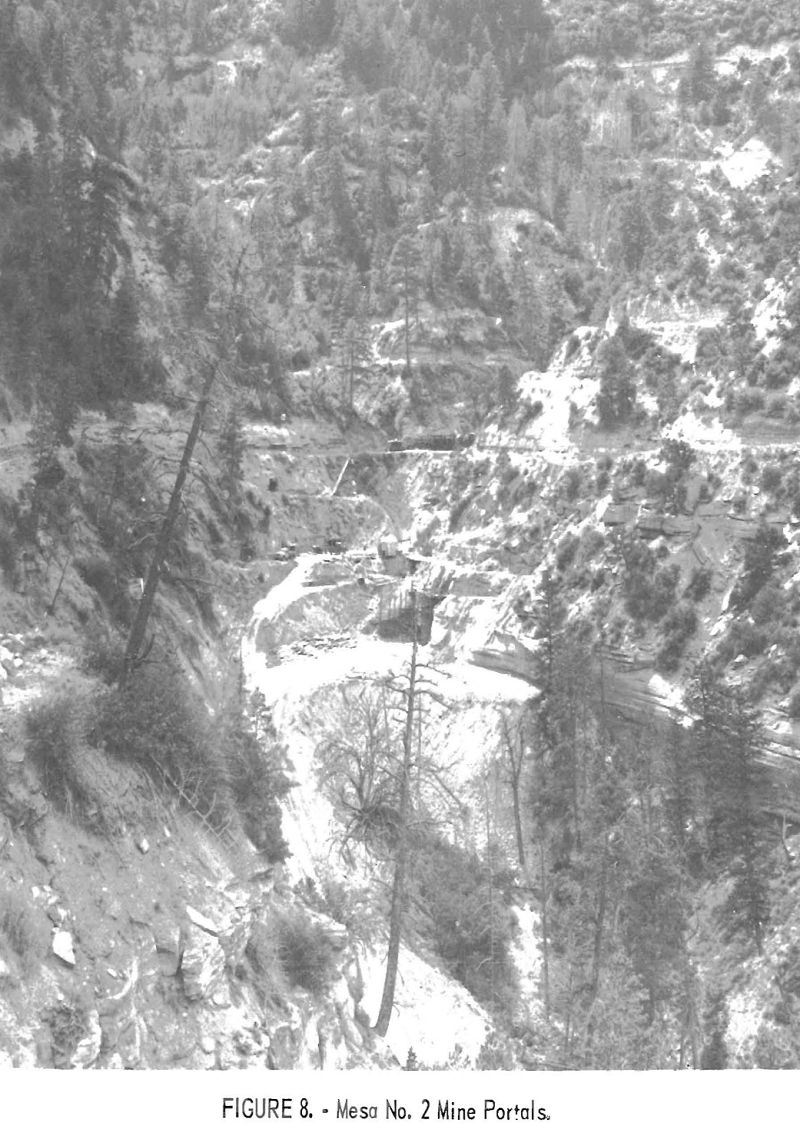
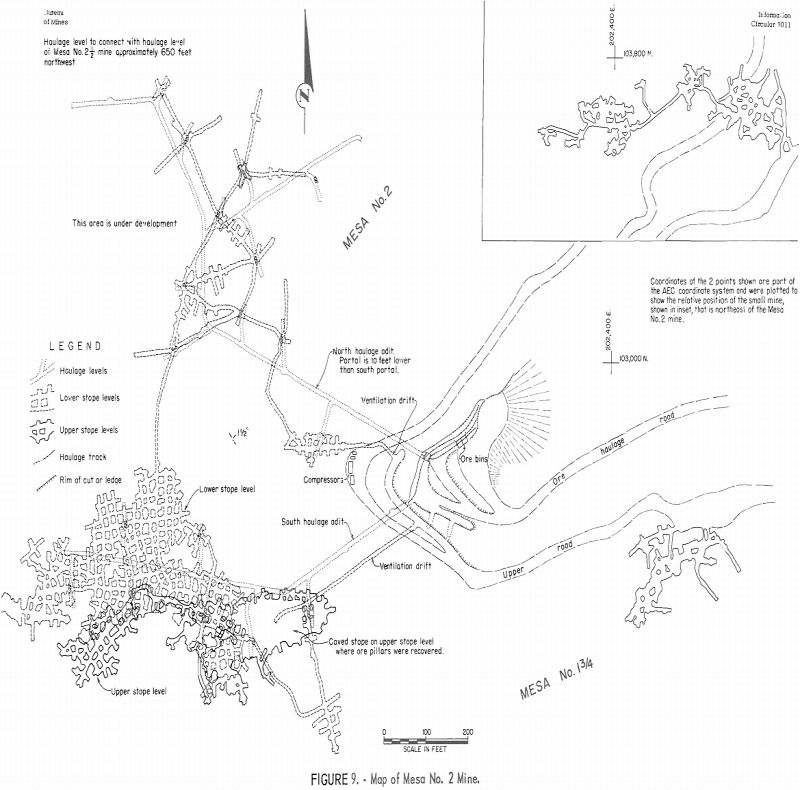
sloughing; occasional sets of 8- to 12-inch round native aspen timber are placed and backlagged with 4- to 6-inch aspen poles Although not usually used for mine timbering, quaking or mountain aspen serves the purpose. The aspen need not support heavy ground in the adits, and it is cheaper than sawed ponderosa pine, which costs $85 M bd. ft. delivered. Some aspen is crooked and difficult to frame, and few of the workmen have had much experience in timbering, so the timber sets are not always textbook examples of framing. Under authorization from the Bureau of Indian Affairs, Kerr-McGee is permitted to cut aspen in the high country in the summer, but is prohibited from cutting any pine on the reservation.
Jack Landon, mine superintendent, estimated that to keep development abreast of mining, approximately 25 percent of the mine crew (5 to 6 men in each 21-man shift) has been kept in development headings. During a representative period (January-August 1958), 2 of every 10 tons of rock brought to the surface was waste.
Most of the ore produced from the Mesa No. 2 mine has been stoped by the room-and-pillar method. Where the ore has been less regular, random pillars of both ore and waste have been left. After raises have penetrated the ore zone, they are connected by drifts, driven to explore the intervening ground. These connections are the first step in blocking out an ore body, and they provide ventilation passages between the raises. In ore the drifts are driven 7 to 8 feet wide; in waste they are narrowed to 5 feet. Since the drifts are not always parallel or perpendicular to one another, the resulting blocks of pillars are not necessarily of uniform shape. The headings or rooms are driven approximately on 20-foot centers, and the pillars are 10 to 12 feet square. Except in irregular ore, as near the fringe of an ore body, the minimum pillar size desired is 8 feet square. This is a precaution against developing a structurally weak pillar should additional ore be discovered above or below the stoped-out area. In most stopes the full height of the ore was mined in one pass, but where the ore was thicker than 9 or 10 feet it was broken out in two or more passes, first along the back of the ore and then by underhand stoping the bottom.
The ore is drilled with leg-mounted drills, using 6-foot lengths of 7/8- inch hexagonal steel either integral with 1-17/32-inch tungsten carbide insert-chisel bits or with one-use socket bits (fig. 10). When the gage of an integral insert bit is too worn for use, the bit end is cut off and turned down for use with 1-5/8-inch one-use type socket bits. In Mesa No. 2 ground 6-foot lengths of integral steel drilled an average of 800 to 1,000 feet of hole. A 7- by 7- foot heading round usually is broken with 22 holes, loaded with 1- by 8-inch cartridges of 35-percent semigelatin dynamite. The cut consists of two converging holes, collared about 12 inches apart in a horizontal plane, with single relievers centered above and below drilled parallel to the line of advance. When driving through sandstone the back holes are alined parallel with the bedding planes, whereas in mudstone the back holes are placed so as to arch the roof. Mudstone is difficult to break seldom will a round drilled in mudstone break cleanly to the bottom of the holes, and in tight mudstone 6 to 12 inches of hole usually bootlegs.
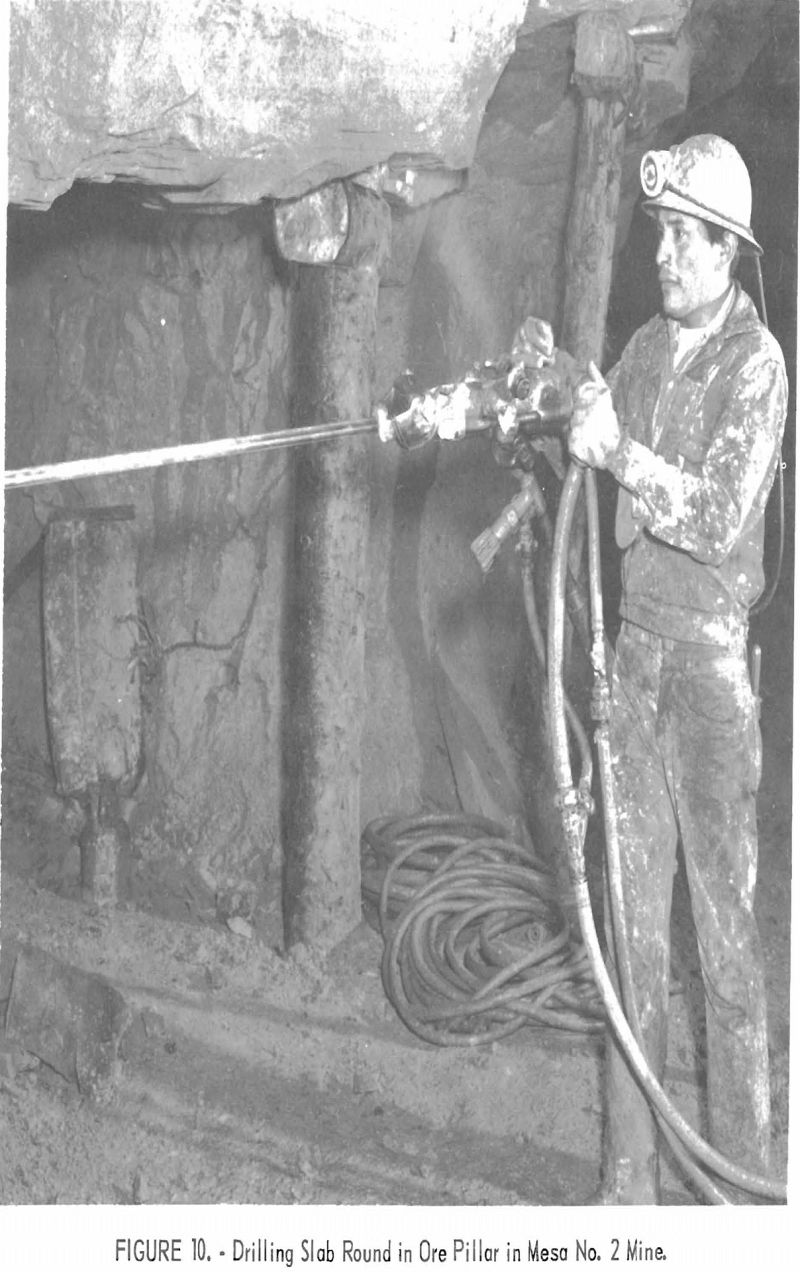
Nearly all the ore is moved through the stopes in pneumatic-tired wheelbarrows (fig. 11). The Navajo Tribal Council encourages companies mining on the reservation to employ as many Navajos as possible-a fact that has influenced Kerr-McGee to hold to this rather primitive system of transportation. However, the productivity of Mesa No. 2 labor is high, compared with the overall average labor productivity for other Salt Wash mines. From January 1 to August 9 1958, production per man-shift for all employees at the mine except the foreman and shifters was 5 2 tons of ore and 6.4 tons of both ore and waste.
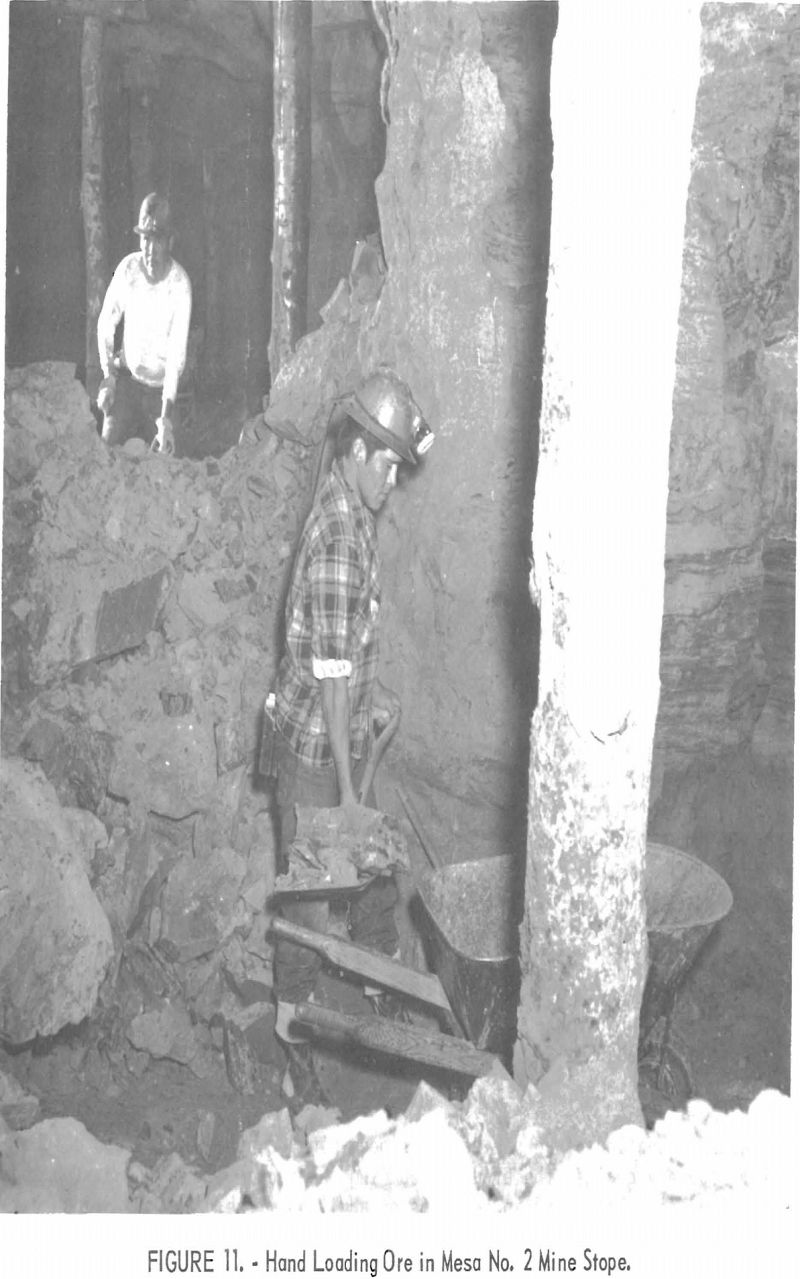
The muckers usually work in pairs, and two men normally clean out a 15 ton round in one-half shift. Five loads in wheelbarrows of 3-cubic-foot struck capacity will move a ton of ore. The average load is about 4 cubic feet and weighs about 400 pounds. The average haulage distance is about 60 feet, and each mucker loads and wheels an estimated 75 loads a shift or approximately one trip every 6-½ minutes.
The average total labor performed by a mucker during an 8-hour shift consists of hand loading 15 tons of broken sandstone rock (20 cubic feet per ton), wheeling one 400-pound load approximately 0.9 mile, and wheeling an empty barrow an additional 0.9 mile. It is interesting to compare the work done by the Mesa No. 2 muckers with work estimates given by Trautwine in 1880 for removing rock by wheelbarrow. Converting from his table; “Hard Rock, by Wheelbarrow,” using an in-place tonnage factor of 14 cubic feet per ton, and adjusting for an 8-hour instead of a 10-hour day, one man should load and wheel 15.8 tons a distance of 60 feet, Trautwine’s figures, however, are based on calculations using a lighter wheelbarrow load (177 pounds) and a greater number of trips per unit of time for any length of haul.
An example of hand loading and wheelbarrow transportation at the Mesa No. 2 mine is the work of James Goldtooth when a 5- by 7- foot ventilation drift was being driven from the south stopes to the surface. Each shift Goldtooth hand-mucked a 12- or 13-ton round and transported the rock by wheelbarrow a maximum of 300 feet in time for the driller to drill; load; and blast a new round.
The company also uses a few small 2-drum 5-hp. air-driven slusher hoists with 30-inch scrapers to convey the ore along the more permanent routes in the stopes. Slushing can be adapted well to the undulating stope bottoms.
Ore on the haulage levels is taken to the surface in 20-cubic-foot-capacity rocker-type mine cars pulled by 1½-ton battery-powered locomotives. In August 1958 when the average haulage distance in the south adit was about 850 feet, the two-man hauling crew pulled out a five-car train every 15 minutes. The ore chutes, framed from ponderosa pine, are 36 inches wide and inclined 55°. The steel overcut arc gates are hand operated by motormen helpers, who stand on timber platforms built opposite the chutes (fig. 12). The haulage-ways are tracked on a 1-percent grade with 20-pound rails laid to 18-inch gage; 30-pound rail is used in the mine yard. The track from the lower north adit was laid across the 12-inch grizzly atop the two 55-ton hopper-bottom steel ore bins, which are in an excavated recess in a sandstone rim of the canyon. The ore brought out of the south adit is dumped from the rocker-type cars from a sandstone ledge about 10 feet above the grizzly. The hopper bottoms on the bins have a 55° slope.
After a section of an ore body has been mined on the advance and before pillar recovery begins, the area surrounding the stopes is tested with short percussion-drill holes for indications of additional ore, Using 7/8-inch hexagonal steel in 4-foot sections,; and 1-7/8-inch tungsten carbide insert cross-bits) 25-foot-deep holes in groups of three are fanned out into the wallrock. The ground above and below the stopes is tested with 8- to 25-foot-deep vertical holes, depending on ore elevations in nearby exploratory holes. Although the color of drill cuttings is an excellent guide to ore mineralization, the holes are probed with a long-hole counter (fig. 13). Downhole drilling was gainful in many instances when as much as 4 feet of ore was found lying beneath the bottoms.
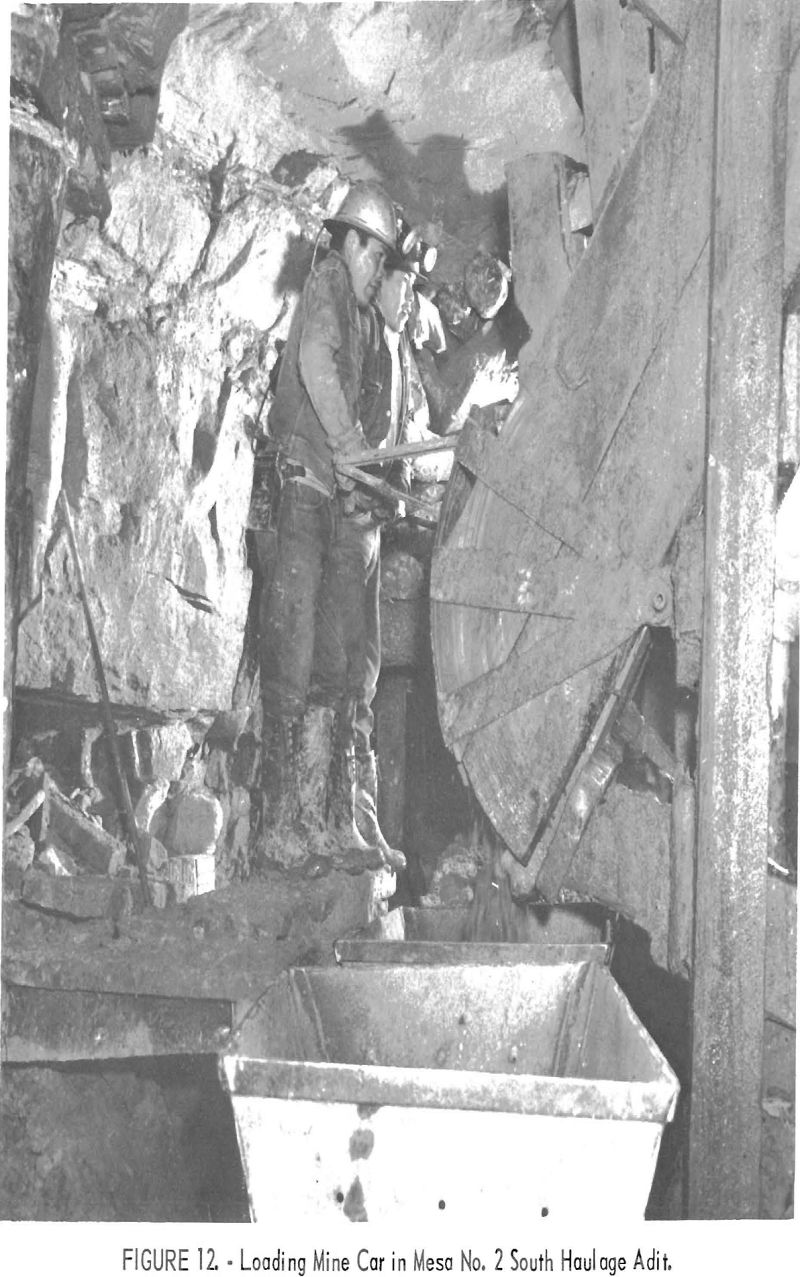
Pillar recovery from the No. 2 mine was started at the east end of the upper ore level above the south adit in August 1958. With four pillars left to support the back at the eastmost raise, pillars were pulled one at a time, working west. Stulls were placed to support isolated slabs and to provide a warning of any impending roof fall (fig. 14) An area of about 80 by 100 feet was opened when warning signs indicated an impending fall. In the Mesa No. 3 mine, a span approaching 80 by 120 feet was opened and has stood for more than 2 years; only slabs break loose occasionally. From experience gained in the area, investigators concluded that the back should have at least 5 feet of
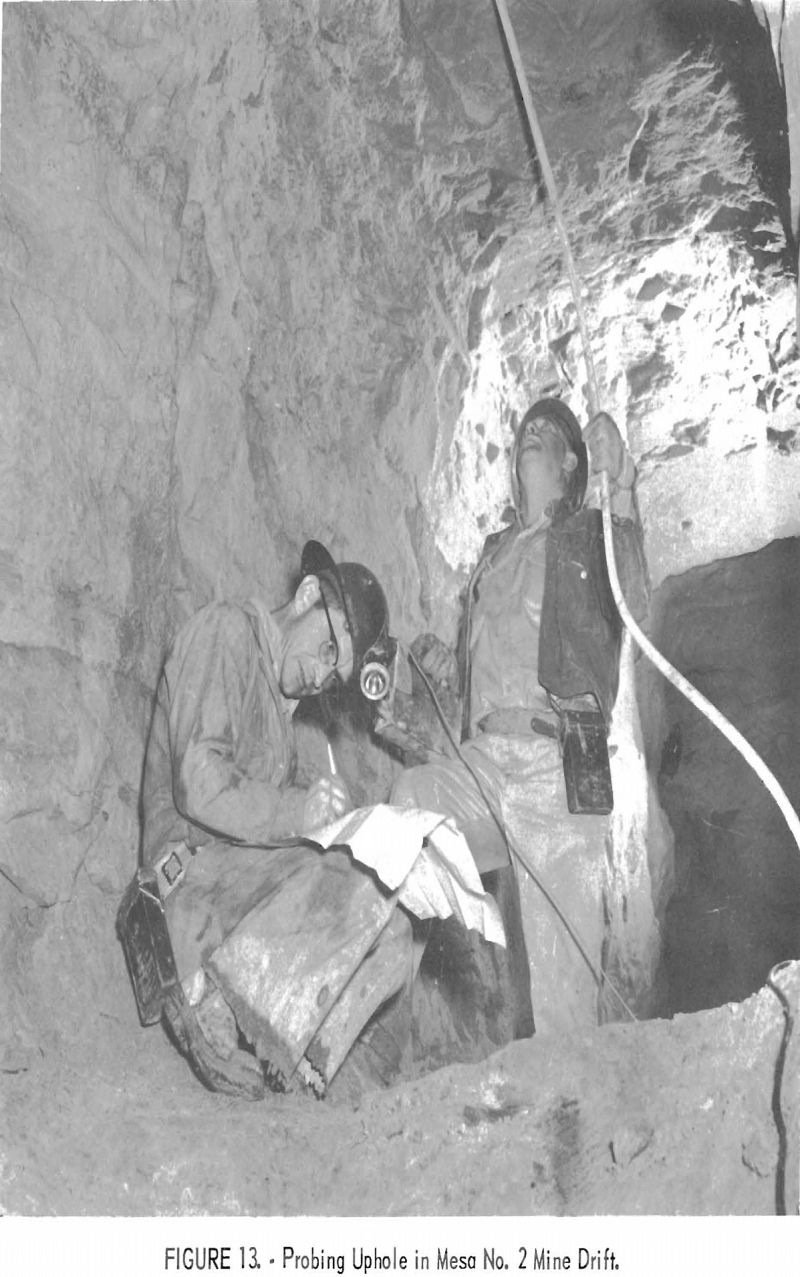
strong unfractured sandstone if an unsupported stope 80 by 100 feet is to be opened. To hold a back in mudstone, the whole area of mudstone that is exposed must be cribbed and lagged. Consequently, where the sandstone lense is of ore grade to its contact with an upper mudstone layer, ore recovery drops.
There is no definite system of retreating when recovering pillars. Because of the distribution of pillars, positions of some waste pillars among ore pillars, and changes in the character of the back, the practice so far is simply to take as much ore as possible with safety. Rows of stulls are kept
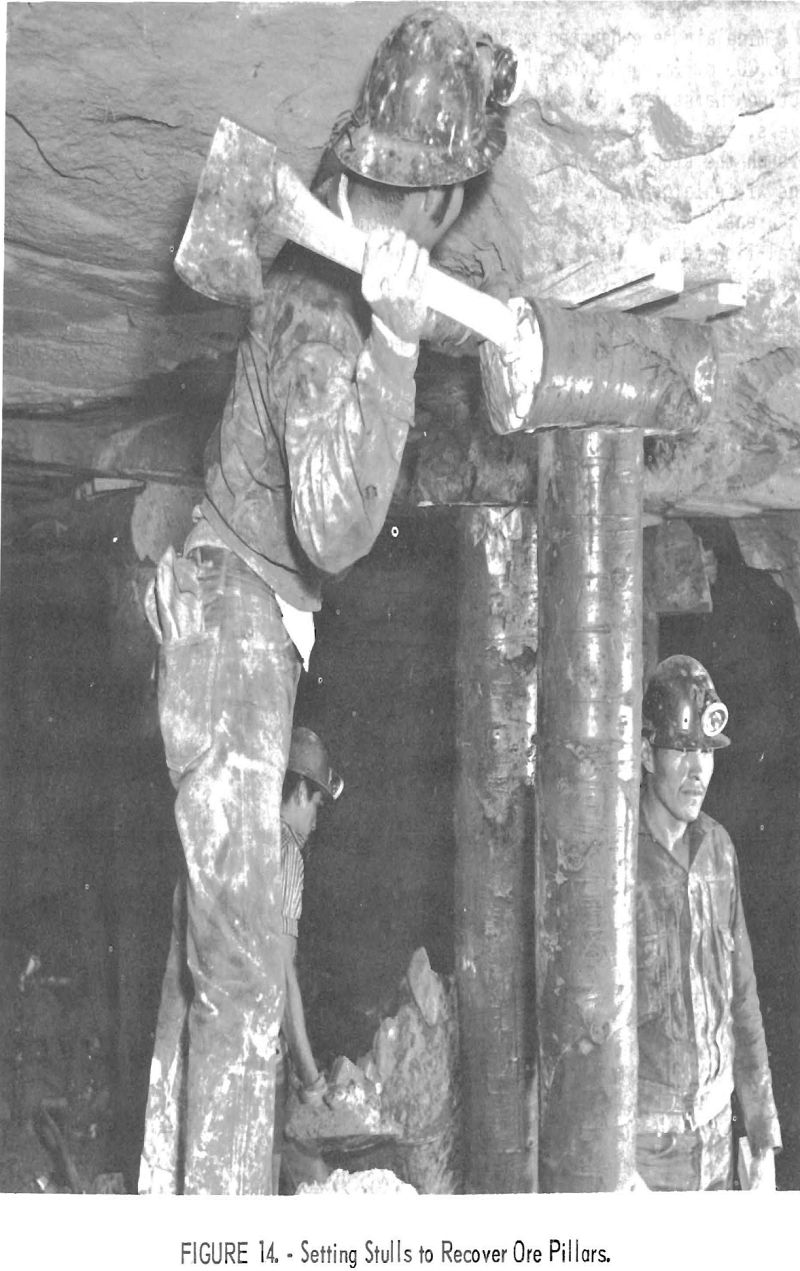
between the caved sections and the working faces. When the stulls and back give signs of movement before mining is completed, the area is left until it becomes quiet. Waste pillars cannot be left after being passed by the retreat line but must be broken. Caving also may have to be induced in some sections to control the fall of roof
Compressed air is furnished by one 600-c.f.m. rotary compressor and two 315-c.f.m., two-stage, piston-type compressors. The compressed air is delivered underground through 4-inch pipe hung down drill holes that intersect the workings.
Mine air is exhausted by two electrically driven 36-inch disk fans rated at 16,000 c.f.m, and mounted at the portals of the two ventilation drifts connecting the stopes with the surface. Air enters the mine through the haulage levels, travels up the manway compartments of the raises, and then passes through the stopes and out. Exploratory drill holes that intersect the workings are enlarged from 4-¾ to 8 inches and act as air intakes near the working areas. Air is forced to dead-end workings with small compressed-air-driven axial-flow fans blowing through 8-inch ventilation tubing. These setups have a capacity of about 600 c.f.m. when blowing through 300 feet of tubing.
Forty-two men comprise the underground labor force at the No. 2 mine. The mine is operated two shifts a day by two 21-man crews alternating shifts every 2 weeks. Two general labor rates are paid: The miners, drillers, timbermen, trackmen, motormen, slushermen, and mucking-machine operators earn $1.70 an hour; muckers earn $1.50 an hour. The company pays social security, unemployment compensation, and workmen’s compensation and liability insurance on the wages earned. The miners live within approximately 30 miles of the mine and commute to work daily by car, horseback, or on foot.
An independent trucker hauls the No. 2 mine ore from the mine bins to the mill at Shiprock for $0.075 a ton-mile. In the first of two steps, two end-dump tandem-drive trucks carry the ore down the 4-½-mile, steep, winding dirt road from the mine to the camp where they dump the ore at a stockpile (fig. 15). Together the two trucks haul 34 tons each trip and with good road conditions make the round trip every 60 minutes. The trucks travel together to eliminate the need of passing one another on stretches of single-lane road. The grade of the mine road is 18 percent in places, and because of sharp switchback turns, larger trucks could not make the run as easily. From the stockpile at the camp, the ore is reloaded with a 1-¼-cubic-yard Michigan 75A loader into larger trucks, which haul the ore 40-½ miles to the mill (fig. 16). Either 21-ton, cable-dump, semitrailer trucks or 25-ton trains of smaller semitrailer, cable-dump trucks pulling four-wheel trailers are used. The contractor does the loading. Besides the $0.06 per ton mile paid by the AEC for hauling the ore to the mill, Kerr-McGee pays $0.64 per ton.
Principal items of equipment used at the Mesa No. 2 mine consist of the following :
1 Compressor, rotary, 600-c.f.m., Ingersoll-Rand Gyroflo; diesel-drive.
2 Compressor, 2-stage, 315-c.f.m., Jaeger; diesel-drive.
2 Locomotive, battery, 1-½-ton, Mancha.
1 Locomotive, compressed-air, Tramaire.
15 Mine car, rocker-dump, 20-cu.-ft.
8 Mine car, end-dump, 20-cu-ft.
1 Loader, overhead, Eimco 12B.
4 Scraper hoist, 2-drum, 5-hp., air, Gardner-Denver HEE.
7 Drill, airleg-mounted, Atlas Copco RH-657.
1 Stoper.
2 Fan, disk-type, 36-in. , 16,000-c.f.m,. approximately.
5 Blower, compressed-air-driven, Coppus Vano SP-175.
1 Tugger, 1-drum, 5-hp., air, Gardner-Denver.
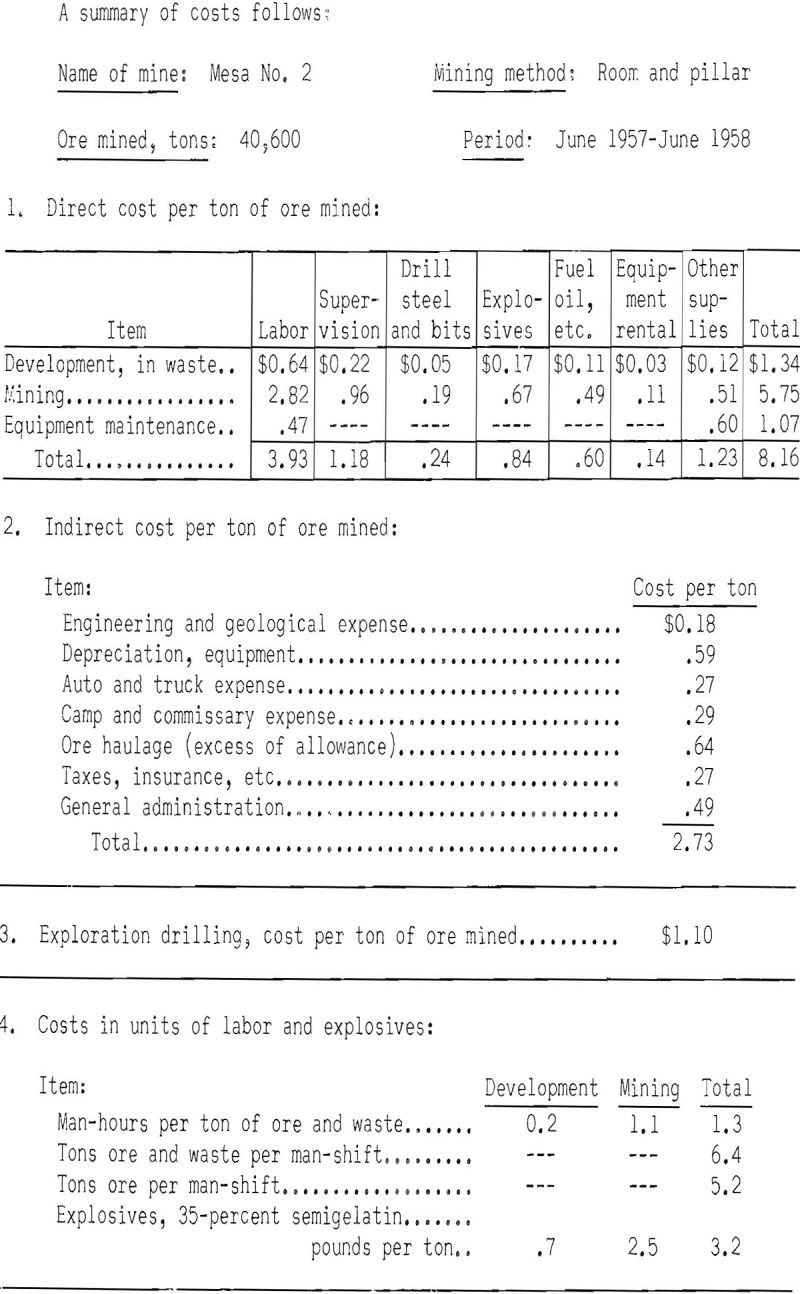
Contract-Mining Operations
In mid-1958 Kerr-McGee had four small contract-mining operations. To encourage production from the small and irregular deposits, the contractors, who in effect are shifters for the company are paid according to the value of the ore produced. Each operator has direct control at his mine, but the company sees that the mines are operated safely and Tribal mining requirements
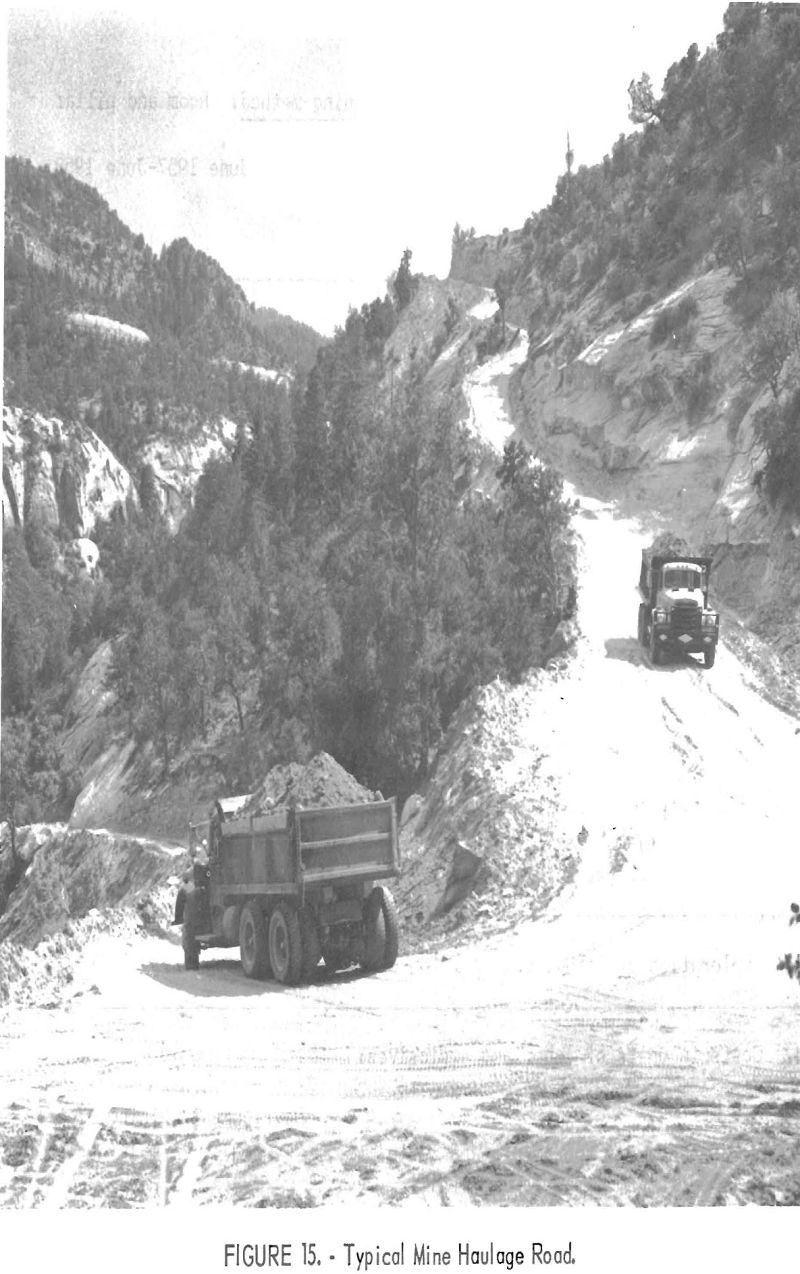
are met, and provides engineering and geologic services. Most of these contractors are paid a 50-50 split of gross returns from the ore. However, if the ore occurrence is very spotty or if the work consists of cleaning up an old mine, the contractor’s percentage of the gross is increased accordingly, to 60 percent or more.
The company does all the clerical work for its contract operations. When an operator employs a new man; he sends the man to the company field office at Cove, where all necessary forms are completed. The contractor has no payroll
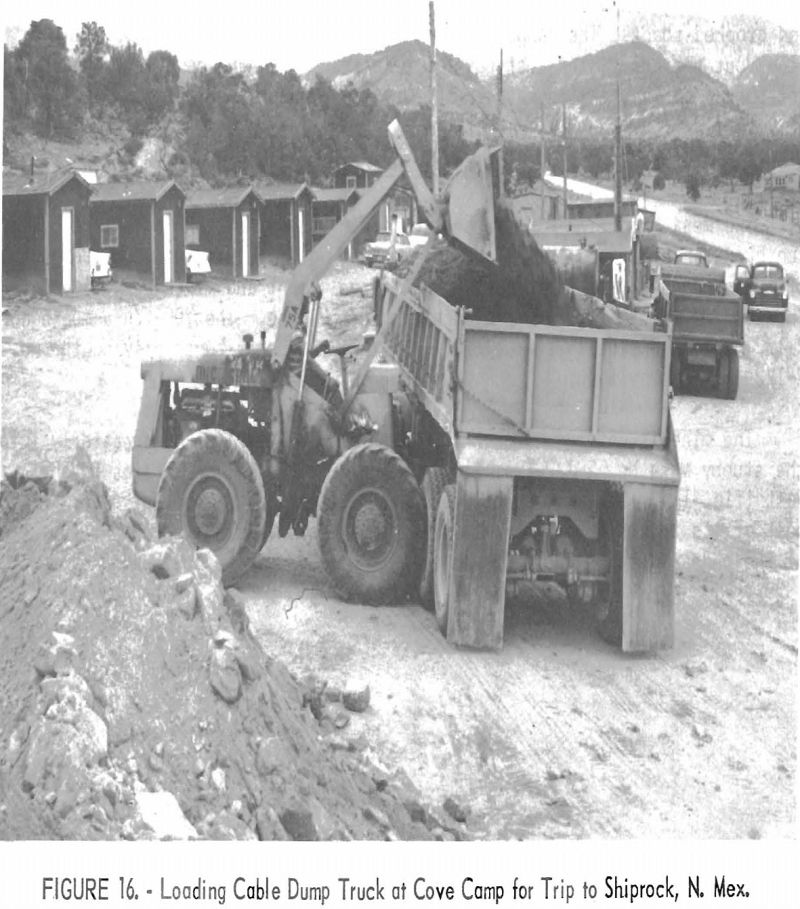
records to keep but has only to turn in his men:s time every 2 weeks. The company computes the wages earned- makes the necessary payroll deductions; and issues the payroll checks. The company charges the contractors a flat 15 percent of their payrolls to cover the cost of unemployment compensation, workmen’s compensation and liability insurance, and company costs of such company-employee participation programs as the retirement plan, the hospital- medical-life insurance program and a thrift plan. The company recovers the amounts due it by making deductions from the contractors production returns.
Kerr-McGee supplies all timber, track, and pipe. The contractor can buy other supplies from the company, which will deliver them to the camp for the original cost plus 10 percent to cover overhead. The contractors usually supply their own equipment, but if they are unable to do so, the company has furnished equipment on a rental basis. The average direct mining cost for the contract operations was $13.41 a ton from June 1957 to June 1958, or $5.25 a ton more than the cost at the noncontract mine.
Kerr-McGee contract miners contract their hauling to small-scale trucking concerns, which use single axle-drive end-dump trucks to take the ore directly from the mines to the mill. The small bobtail trucks are adequate for the smaller tonnage involved and can be operated to better advantage on the narrow and crooked roads. The company pays the haulage allowance of $0.06 per ton-mile, but the contractor must pay the balance of the haulage charge, which is determined by negotiation between the contractor and the haulers.
Mesa No. 2-½ -Mine
The Mesa No. 2-½ mine, one-half mile northeast of the No. 2 mine, is run by Allen Sphar and Lee Allmon, of Cortez, Colo. Their pay is 50 percent of gross returns from the ore produced. Development and mining practices are the same as those at the company-operated No. 2 mine. The 700-ton-a-month No. 2-½ mine is basically a wheelbarrow operation. Sphar began driving the No. 2-½ adit in May 1956.
The mine is entered through a 6- by 6-foot adit driven southeasterly into the stubby Mesa No. 2-½ from its junction with Mesa 3, which lies to the west (fig. 17). The adit portal is in sandstone at an outcrop of ore. For most of its length, the 870-foot adit roughly parallels the northwest strike of the beds and its downdip from the major ore pods. The northwest heading
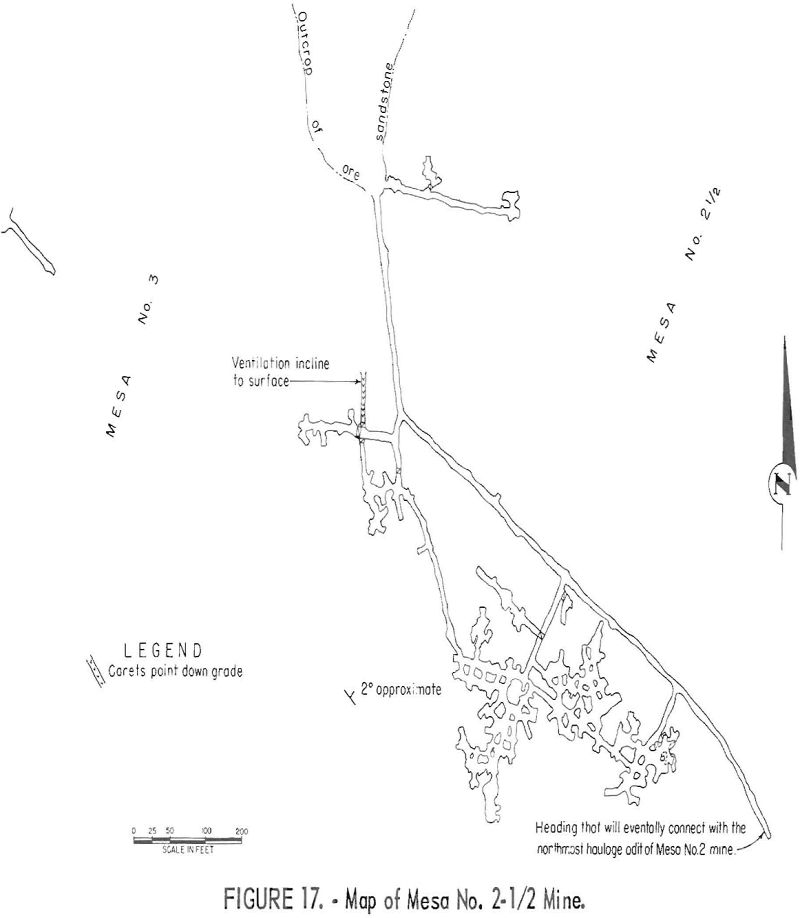
from the Mesa No. 2 mine, which lies to the south, should connect with the 2-½ adit in mid-1959.
The ore pods generally have been thinner than at the No. 2 mine, but in places they have reached a maximum thickness of about 13 feet. Most ore has been opened by stopes benched 2 to 10 feet above track level. Some ore, 15 feet above track, is reached through raw-ore passes. A few sets of round aspen timber were needed in the haulageways.
Drilling is done with the same type of machines and drill steel as are used at the No. 2 mine. The same kind of machines, with 3-, 4-, and 6-foot lengths of sectional steel, are used to fan out 25-foot holes into the walls and 10-foot holes into the backs and bottoms to explore for additional ore. This drilling revealed layers of ore above and below the stopes. Drilling water is hauled 8 miles from the spring between Mesa Nos. 1 and 2.
Most ore is mined by simply following the best exposures. Randomly spaced pillars of waste and occasional pillars of ore are left for back support.
Each face is checked with a geiger counter before it is drilled. The partners never ship ore containing less than 0.20-percent U3O8 and blending is usually necessary to maintain this grade. Most ore is moved through the stopes in wheelbarrows and dumped into timber-slide chutes to fall into 16-cubic foot end-dump cars spotted beneath them. Two small 5-hp., double-drum, air-operated slushers are also used on scraper slides to load the cars in the haulageways beneath the open ore passes. When loading rock broken in a development drift, the slide is kept about 100 feet back from the face. The mine cars are pulled to the 75-ton steel hopper-bottom bin on the surface by a small compressed-air-driven locomotive over 20-pound rail laid to 18-inch gage.
The partners employ 11 Navajos, who work one shift a day. Five are miners and six are muckers, and they are paid company rates.
The major items of equipment used at the No. 2-½ mine consist of the following:
1 Compressor, 2-stage, water-cooled, 500-c.f.m. , Gardner-Denver WH-500-:diesel-drive.
1 Compressor, 2-stage, water-cooled, 365-c.f.m., Gardner-Denver WH-365;diesel-drive.
1 Locomotive, compressed-air, Universal Tramaire,
7 Mine car, 16-cu.-ft, end-dump.
2 Slusher hoist, 2-drum, 5-hp., air, Gardner-Denver HEE
3 Drill, airleg-mounted, Gardner-Denver S58.
Mesa No. 1-¾ Mine
The Mesa No. 1-¾ mine is a small mine about one-half mile southeast of the No. 2 mine. The mine is entered through a 300-foot-long timbered incline driven at minus-22° from a portal at the south end of Mesa No. 1-¾ (fig. 18). John and Jim Goode began sinking the incline in July 1956.
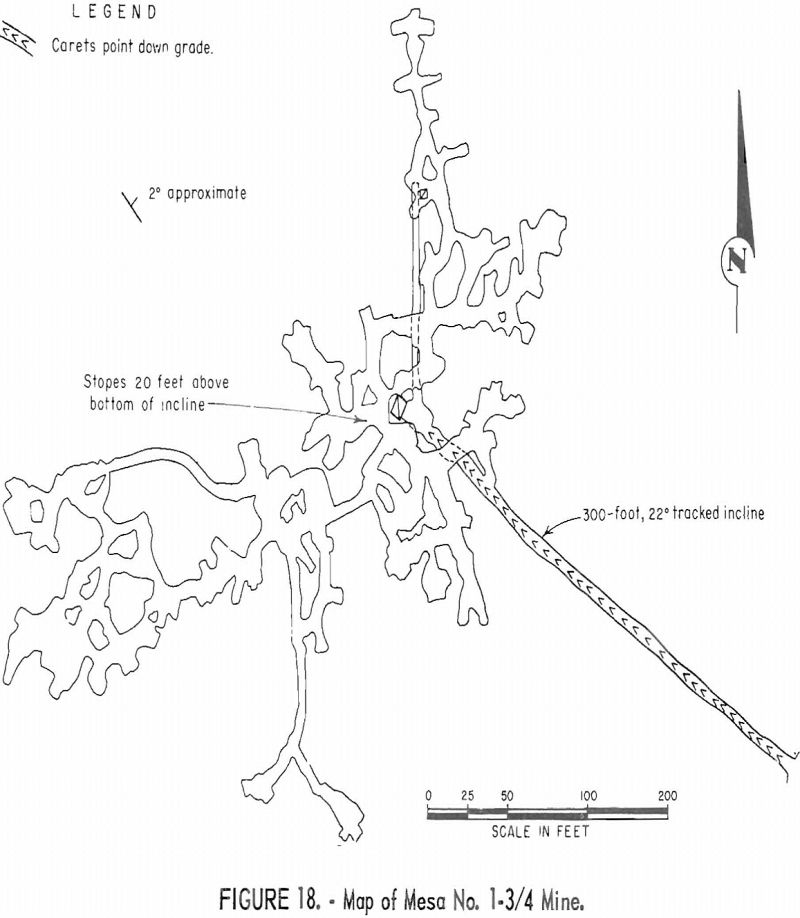
The incline bottoms 20 feet beneath the northeasterly dipping ore zone, and except for a short haulage drift driven north beneath the ore, all workings are in the ore zone. The ground is broken and handled in the same manner as at the No. 2 and 2-½ mines. The 16-cubic-foot -capacity end-dump mine cars are hoisted to the surface, one at a time, with a small single-drum gasoline-powered hoist. The ore has averaged about 4 feet thick.
At this 350-ton-a-month operation, air is forced underground by small centrifugal blowers mounted on the surface at the collars of 8-inch drill holes, which intersect the workings. Underground, the air is boosted to the working areas through 8-inch ventilation tubing by small axial-flow air- driven blowers. In 1959, this mine was connected with Mesa No. 2 mine to the north.
